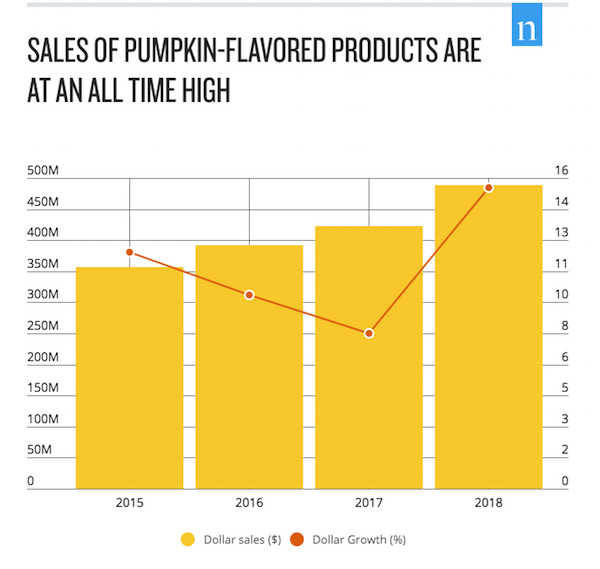Throw some pumpkin spice on it and call it a day!
Marketers are having a hay-day (pun intended) with pumpkin spiced everything – and this year the ubiquitous squash made its annual return before we even had time to store away our white linen shorts. As the weather in Atlanta shifted from a suffocating 92 degrees to a sweltering 89, autumn lovers everywhere marked their calendars for August 28th and the return of the pumpkin treat that started it all: Starbucks Pumpkin Spice Latte (aka “the PSL”).
When Fortune, Business Insider, and practically every other news outlet, announced the 2018 debut of this sweet coffee drink, Millennials across the nation dusted off their booties for fall-themed Snapchats, as Marketers everywhere turned to the drawing board with one question:
“How can we capitalize on this PSL craze?”
After all, since the seasonal offering’s inception in 2003, Starbucks has sold over 350 million Pumpkin Spice Lattes. And, Nielsen reports that 2018 sales of products with pumpkin flavorings reached roughly $489 million (in the 52 weeks ending August 25, 2018) – which is an all-time high and a 15.5% growth from 2017. Historically used for pie-making, this aromatic spice blend consisting of pumpkin, cinnamon, nutmeg, ginger, and clove, is now rearing its round, orange head everywhere you turn.

Source: Nielsen Retail Measurement Services, Total U.S. All Outlets Combined (xAOC), 52 weeks ended Aug. 25, 2018, vs. previous annual periods.
No doubt, brands everywhere are racing to new product development with pumpkins in hand. From food to liquor to gum, candy, beauty products, household items, pet products, and even deodorant (what!), pumpkin spice is dominating all other seasonal flavor and aroma trends. But for all the gourd-haters out there, you can rest assured that as quickly as pumpkin jumped on our summer shelves, most of the products will creep away by the end of November.
The pumpkin product market is clearly saturated, so I’m not suggesting you throw some spice on your products and call it a day. Seasonal or otherwise, it’s imperative that any new product or service offering is rooted in your brand’s Story, that you have a clear Strategy, and aligned Systems (people, processes and technology) in place for R&D, positioning and launch.
Starbucks approach to Storytelling
Start with your Story and start from the inside out. If your own employees aren’t your greatest brand ambassadors, then who will be? This is something that Starbucks excels at. For a brief stint right out of college, I worked as a Starbucks barista. And, aside from the much-needed, never-ending stream of caffeine it gave my 21-year-old body, it made me feel part of a bigger plan and a bigger purpose that revolved around social impact. I remember feeling empowered after the new hire training sessions and like we (as a brand) were really making a difference in our customers’ lives, in our neighborhood, and in the lives of farmers, producers, and coffee growers.
At its core, Starbucks’ brand is about human connection. And, their approach to marketing the signature fall drink is no different: it’s based on creating a community that’s rooted in authenticity and fueled by customers’ experiences of the brand. They have extended their in-store coffee shop culture to the digital space by creating highly engaged social media platforms that thrive off of user-generated content and making the customer the hero. Forbes stated, “Starbucks is at the leading edge of a fresh approach to brand storytelling. While other brands are creating content about their products, Starbucks is building a stronger, emotional connection with its customers through stories that reaffirm people’s faith in humanity. The stories further cement the relationship between the brand and its loyal customers.”
Scarcity Marketing Tactics
There’s no question that PSLs could sell year-round; just ask the 37,000+ members of Starbucks “Leaf Rakers Society” – a private Facebook group designed for pumpkin-consuming, scarf-wearing, sweater-wearing, year-round-fall-lovers. Yet, limited availability is part of the reason we’re even talking about pumpkins today in the first place. You probably aren’t seeing much hype about vanilla lattes on your newsfeed.
Scarcity generates a sense of urgency. And, the fact that PSLs are only available for a short period of time in limited quantities is appealing. I vividly remember when the small store I worked at was on its last bottle of pumpkin spice syrup. We told a customer that it would probably be the last day for the drink, so she quickly ordered six more to take to her fellow pumpkin-loving coworkers. Dr. Michael Lynn, a professor at Cornell explained the following three reasons why scarce items increase desirability: they feel exclusive, appear more valuable and make people feel powerful. If you have ever fallen for an e-commerce site’s, “Hurry! Only 2 left in stock!” message, then you have been the subject of a scarcity marketing tactic.
On top of product scarcity, another approach is information scarcity – leaking just enough information to get people talking and searching for more. The Starbucks PSL rumor mill started swirling weeks before the launch when they said, “It’s never too early to celebrate fall, right?” on Twitter. Apple is also notorious for this: dropping hints and teasing us with images that say things like, “Wish we could say more.”
Using scarcity tactics, in limitation, can work as a great motivator for conversion. But, don’t expect scarcity to create loyalty. The long-term success of your brand depends on creating consistent and authentic experiences for your customers. Demand is built and nurtured over time, but only when the right Story, Strategy & Systems are in place to sustain it…and maybe when a little bit of pumpkin is thrown on top.
Subscribe to our email list if you’d like more transformational marketing insights and practical tips to accelerate growth.